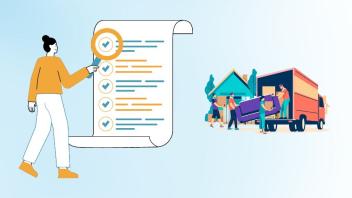The Ultimate Packing Checklist For College Students

Starting college is an exciting new chapter in a student's life. However, the process of packing and moving can be overwhelming. This ultimate packing checklist will help college students ensure a smooth transition to their new home away from home. We'll discuss the importance of each tip, common mistakes, and how to do it properly.
Packing Checklist For College Students
#1 Bedroom Essentials
The bedroom is your personal sanctuary in college. Here are the essentials you need:
- Bedding: Bed sheets, pillows, pillowcases, blankets, and a comforter.
- Closet: Hangers, under-bed storage, and a laundry hamper.
- Electronics: Extension cords, phone charger, and an alarm clock.
- Miscellaneous: Desk lamp, wastebasket, etc.
#2 Bathroom and Cleaning Supplies
You'll need some items to maintain cleanliness and personal hygiene:
- Towels: Two sets of bath towels, hand towels, and washcloths.
- Toiletries: Toothbrush, toothpaste, shampoo, conditioner, soap, razors, and personal grooming items.
- Cleaning Supplies: Disinfecting wipes, a mini vacuum cleaner, broom, and dustpan.
#3 Kitchen Essentials
Whether you have a shared kitchen or a personal one, you'll need some basics:
- Utensils: Plates, bowls, glasses, silverware, and a can opener.
- Appliances: A microwave and a mini-fridge, if allowed by the college.
- Miscellaneous: Dish soap, sponge, and a multipurpose cooker like an Instant Pot.
#4 Study Essentials
Having a dedicated study space can significantly enhance your productivity:
- Stationery: Pens, pencils, erasers, notepads, sticky notes, and binders.
- Electronics: Laptop, headphones, and a printer if needed.
- Miscellaneous: Desk organizer, a comfortable chair, and a whiteboard or corkboard.
#5 Personal Items and Documents
Keep your personal items and essential documents close:
- Documents: ID proof, insurance cards, driver’s license, passport, and Aadhar Card.
- Miscellaneous: Prescription medicines, glasses, and any other medical necessities.
But why stress over packing and moving when you can leave it to the professionals?
How to Prepare for the Move
Plan and Organize
Planning and organizing are essential for a hassle-free move. It helps you avoid forgetting important items and ensures that everything is packed efficiently. Creating a packing list helps to ensure you don't forget any essentials and that you only bring what you need. A well-organized list minimizes the likelihood of overpacking or under packing, reducing stress and simplifying the process of setting up your new space.
Common mistakes: Students often underestimate the time and effort needed for packing, leading to last-minute chaos and leaving essential items behind.
How to do it properly: Start planning at least a month in advance. Make a list of items to pack, categorize them (clothing, electronics, toiletries, etc.), and prioritize based on necessity. Create a moving day checklist to ensure you don't miss anything important.
Pack Smartly
Smart packing helps protect your belongings during transit and makes unpacking easier. Quality packing materials provide the necessary protection for your belongings during transport. Proper packing materials prevent damage, ensuring your items arrive at your new home in the same condition they left your old one. Investing in quality materials also reduces the risk of accidents or injuries during the move.
Common mistakes: Overpacking boxes, not using enough padding, and not labeling boxes.
How to do it properly: Use sturdy boxes and appropriate types of packing materials. Distribute the weight evenly, use padding to protect fragile items, and label the boxes clearly. Check out these packing and moving tips and tricks for more guidance.
Don't Overpack
Overpacking can lead to unnecessary stress, increased moving costs, and limited space in your new living quarters. Clearly labeled boxes make the unpacking process easier and more efficient. Knowing the contents and designated room for each box helps you and any helpers you have, to quickly identify where items should be placed in your new space. This streamlines the moving process and helps you settle in more quickly.
Common mistakes: Bringing too many clothes, shoes, and other non-essential items.
How to do it properly: Be selective with your belongings. Declutter your home before packing and consider donating, selling, or storing items you don't need. Focus on packing essentials and items that are difficult to replace.
Prepare a First Night Box
A first night box contains essential items you'll need immediately upon arrival, making it easier to settle into your new space. A first night box contains essentials you'll need immediately upon arrival at your new home. It ensures you can comfortably settle in without having to search through all your boxes for necessities. This reduces stress and helps you focus on getting acclimated to your new surroundings.
Common mistakes: Forgetting to pack a first night box or not including important items.
How to do it properly: Include items such as toiletries, a change of clothes, important documents, electronic chargers, and basic tools.
Also read: Everything You Need to Pack in your Overnight Bag While Making a Move
Keep Important Documents Safe
Keeping important documents safe ensures you have access to crucial information and identification during your move and after settling in. Keeping important documents safe during the move is crucial. Losing or damaging these documents can result in serious consequences, such as losing access to essential services, financial accounts, or academic records. Safeguarding your documents ensures a smooth transition to your new college life.
Common mistakes: Packing documents in inaccessible boxes or not keeping them secure.
How to do it properly: Keep essential documents, like your ID, passport, admission letter, and insurance
Choose the Right Moving Truck
Selecting the right moving truck size ensures all your belongings fit and arrive safely at your new destination. Prioritizing and downsizing your belongings helps save time, effort, and moving costs. By only bringing what you truly need, you can maximize your new living space and avoid clutter. This also makes the unpacking process more manageable and helps you settle into your new environment more quickly.
Common mistakes: Choosing a truck that is too small or too large, resulting in damaged items or wasted space.
How to do it properly: Assess the volume of your belongings and pick the right moving truck size. You can also consult a professional moving company for advice.
Coordinate with Roommates
Coordinating with roommates helps avoid duplicate items and ensures a smoother move-in process. Coordinating with roommates helps avoid duplicate items and ensures a smoother move-in process. Good communication before the move can also help establish a positive relationship with your roommates and set the stage for a harmonious living arrangement.
Common mistakes: Not communicating with roommates about what each person is bringing, resulting in unnecessary duplicates or missing essentials.
How to do it properly: Get in touch with your future roommates and discuss what each person plans to bring. Share your packing list to avoid overlap and consider splitting the cost of shared items, such as kitchen appliances or cleaning supplies.
We know that moving to college involves much more than just packing and moving. There are countless other things to plan and prepare for this exciting new chapter. So why not focus on those important tasks and let us handle the packing and moving for you?
Safeguard Your Electronics
Properly packing electronics and appliances prevents damage during transit and ensures they are functional in your new home. Properly packing electronics and appliances prevents damage during transit and ensures they are functional in your new home. Replacing or repairing damaged items can be costly and time-consuming, so taking the necessary precautions during packing can save you money and hassle in the long run.
Common mistakes: Not using the original packaging, insufficient padding, or not preparing appliances for transport.
How to do it properly: Use the original packaging, if available, or sturdy boxes with plenty of padding. Prepare electronics and appliances for moving by detaching cables, removing batteries, and securing any moving parts.
Consider Storage Options
Storage options provide a safe place for belongings that don't fit in your new living space or aren't needed immediately. Storage options provide a safe place for belongings that don't fit in your new living space or aren't needed immediately. This helps you avoid overcrowding your new living space and allows you to retrieve items when needed. A storage facility also ensures your items are secure and protected.
Common mistakes: Overcrowding your new living space with unnecessary items or leaving them with family and friends who may not have adequate storage.
How to do it properly: Research local storage facilities or warehouse storage tips for more information on storing your items securely and affordably.
Update Your Address
Updating your address ensures you receive important mail and packages at your new location. Updating your address ensures you receive important mail and packages at your new location. This helps you stay connected with essential institutions and services, such as educational institutions and government agencies. Failing to update your address can result in missed correspondence, late fees, etc.
Common mistakes: Forgetting to update your address or not notifying important institutions, such as banks and schools.
How to do it properly: Follow this address change guide to ensure you've updated your address with all necessary parties.
Conclusion
Moving to college is a big step, and you might be feeling a mix of excitement and nervousness. It's a fresh start, a chance to meet new people and gain new experiences. Remember, this packing list is a guideline, and you might need to adjust it based on your needs and the specifics of your college and dorm. By following these tips and properly planning and executing your move, you'll be well-prepared for the exciting new chapter of your college life. Happy moving!











